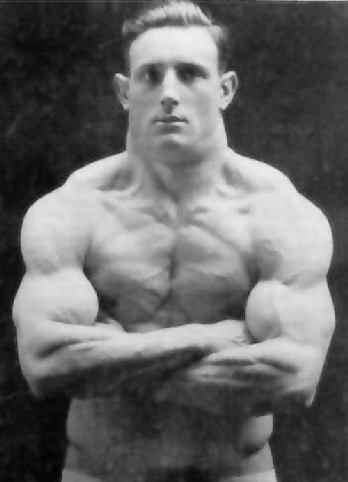This is an article from Alan Calvert that was originally produced in an issue of Klein’s Bell (Siegmund Klein’s magazine from the 30’s).
I thought it was interesting for anyone intrigued by muscle control. It describes a series of muscle controls I’ve never otherwise heard of, or definitely seen before. It would be interested to work on this feat…
An English muscle enthusiast wrote me of seeing a posing exhibition by Alan Mead, during which that expert turned his back to the audience and made the muscles alongside the spine move so that they appeared to run up and down.

Alan Mead was especially muscular for his day and age.
To flex the full length the erector spinae so that they stand out like two great vertical cables is no trick at all. All you have to do is to lean back a bit from the hips, and concentrate on hardening the muscles in question. Then they will be impressive or not according to the size to which you have developed them.
But this stunt of Mr. Mead is one of the few novel things in the line of muscle-control. When I first saw his pictures I noticed that he had the rare ability to display cross ridges in some of his muscles – just as though a long muscle was composed of circular cross sections strung together. He can even make his biceps take on a corrugated appearance when flexed; and in many of the photos of his back, the muscles alongside the spine appear as cables with parallel ridges.
When you have a row of electric bulbs you get the effect of motion by momentarily lighting one bulb after another. Apparently that is what Mr. Mead does with his spinal muscles. He must, for instance, flex the lower sections right above the hip bones (pelvis), relax that section, harden the section next above, and so on; thus giving the impression that the muscles are moving, altho he stands with his back flat and his spine straight. And, of course, after the top section has been contracted he can reverse the process, and make the flexed part of the muscles descend rapidly from the shoulder blades to the waist line.
I imagine that is the way he does it. If you stand with your back towards a wall and your heels, say, eight inches from the base-board and t hen lean back, raise your arms and touch the wall with your fingertips, you will feel the muscles along your spine tighten. You can increase the tension by hardening them still further by will power. Then, without altering your position, relax the muscles, tense them again, and repeat several times; so that you feel the muscles along either side of the spine alternately tightening and softening. Every day back a little closer to the wall, and repeat the practice. Before long you will be able to stand bolt upright and make your spine muscles rise and fall by mental control.
Still you will not be able to duplicate Mr. Mead’s stunt; for, remember, he does not harden the muscles from end to end, but a little bit at a time, so that the muscles seem to have a life of their own, and the ability to flow up and down.
Undoubtedly, he has cultivated the power to thus flex the horizontal sections separately. But then the fibers of the spinae muscles are attached to the processes of each separate vertebrae of the spine, and if he can make an almost imperceptible bend between two vertebrae, he can isolate the fibres attached to those adjoining sections.
Now that he has shown it to be possible, doubtless others will duplicate the feat. The matter of muscle-control is still in its infancy. There are dozens of feats theoretically possible, but not yet displayed.
For more information on muscle control check out the big article All About Muscle Control here.
